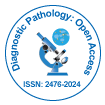Identification of Haplogroups and Molecular Markers in Skeletal Samples Excavated from the Ancient City of Resulo?lu (U?urluda?, �orum)
Received Date: Apr 23, 2025 / Accepted Date: May 23, 2025 / Published Date: May 23, 2025
Abstract
Mitochondrial DNA analyses were carried out in order to determine the haplogroups of 6 individuals obtained from the cemetery of Resuloğlu and dated to the Early Bronze Age (EBA III). The individuals to be included in the bioinformatics analysis were evaluated according to their sequence quality and it was decided that 3 individuals could be used in further analysis. Using bioinformatics tools, it was determined that three individuals belonged to the T2e+152, H2a2a2 and JT haplogroups. These results support a link between the origins of the present‑ day European population and the farmers of the Anatolian Neolithic period. Furthermore, a detailed analysis of single nucleotide polymorphisms revealed T16189C and C150T mutations in the two of three individuals, which are associated with the risk of melanoma and cervical cancer‑HPV infection. These molecular findings are consistent with the health profiles of the excavated skeletons, which indicate that the community struggled with infectious and metabolic diseases. The entire study was carried out in the Ancient DNA and Metagenomics Research Laboratory of the Department of Molecular Biology and Genetics, Istanbul University.
Keywords: Bioinformatics analysis; Anatolian neolithic period; Molecular anthropology; Reactive oxygen species; Polymorphism
Citation: Sekmen B, Yavuz S, Mekik SE, Atamtürk D, Duyar I, Arıcan E, et al. (2025) Identification of Haplogroups and Molecular Markers in Skeletal Samples Excavated from the Ancient City of ResuloÄlu (UÄurludaÄ, Ãorum). Diagnos Pathol Open 10:248.
Copyright: © 2025 Sekmen B, Yavuz S, Mekik SE, Atamtürk D, Duyar I, Arıcan E, et al. This is an open‑access article distributed under the terms of the Creative Commons Attribution License, which permits unrestricted use, distribution and reproduction in any medium, provided the original author and source are credited.
Select your language of interest to view the total content in your interested language
Share This Article
Open Access Journals
Article Usage
- Total views: 803
- [From(publication date): 0-0 - Dec 07, 2025]
- Breakdown by view type
- HTML page views: 678
- PDF downloads: 125
